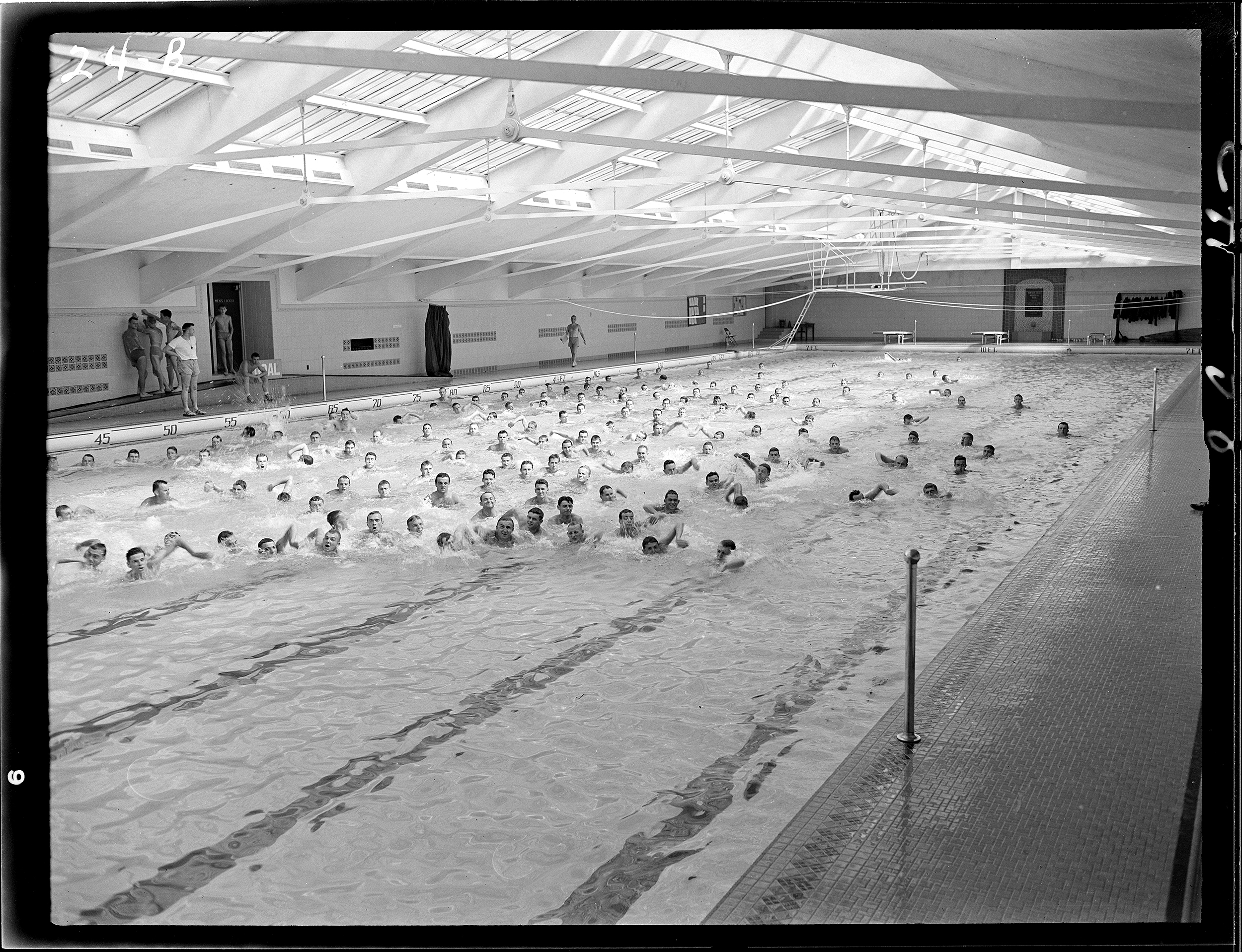Time of Sacrifice: The War in Europe, the Pacific and Chapel Hill
Posted on July 23, 2020
New cadets in first formation, October 1942, on a field where Winston and Connor dorms are now. (North Carolina Collection)
We have never had a simultaneous global leadership stress test like this — one that is testing leaders from the schoolhouse to the White House and from city halls to corporate suites. Everyone will be graded.
— Thomas Friedman, New York Times columnist, April 2020
Many commentators, educators, historians and veterans are more specific: The last time we were tested anything like this was during World War II.
Conditioned by the Great Depression, Americans made a relatively graceful pivot into a long four years of sacrifice. Chapel Hill, already well established as an oasis of progressive thought, its people as skeptical as any of involvement in another large-scale war, found itself in an odd situation.
Not only did the draft and the patriotic fervor for service drain the dorms and the faculty offices — President Frank Porter Graham (class of 1909) offered the country his campus for a good-sized military training camp and lobbied for the honor.

Graduated cadets waiting to leave the preflight school. (North Carolina Collection)
Graham declared that the campus “has offered all its resources to the nation for the defense of the freedom and democracy it was founded to serve.”
The University had a big head start on the athletics facilities the Navy required, and the influence of a former secretary of the Navy, Josephus Daniels (class of 1885). It was picked for one of four Navy preflight schools and also hosted smaller-scale military training programs.
The impact was profound on a small town that normally serviced 4,000 college students — 18,700 men trained at UNC over three years under 1,220 officers. They took what they needed: 10 dorms, two dining halls, two classroom buildings, two assembly halls, fraternity houses, the gym and the pool and all the fields. The University could request the use of Memorial Hall when the Navy didn’t need it.
The Navy continually demanded Navy-quality food in dining halls that weren’t up to it. Parts of the campus were sealed off from civilians at times. The civilian students who remained on campus — many of whom were health-related military rejects — sometimes felt intimidated.
There was, in the words of one close watcher of the town’s affairs, “such an electricity in the air.”
Academic departments altered their curricula to teach courses in military science, Portuguese, Russian, Japanese, electronics and map making. The School of Public Health researched malaria, and the chemistry department studied improvements in manufacturing processes.

A dance for African American cadets, October 1942, probably at the Negro Community Center near the Carrboro border. (North Carolina Collection)
Chapel Hill families were asked to have cadets over for Sunday dinner.
The visitors gave as well. Retail revenues in Orange County soared. Patriotism, too; an all-African American Navy band broke the color barrier as the first black men to enlist at general rank, instead of entering as cooks or porters. They drew respect and inspired black residents as they marched down Franklin Street between campus and Northside, where they ate and slept because facilities on campus were not integrated.
The Navy had its own football and baseball teams, and war put the skills of Otto Graham, Doc Blanchard ’46, Bear Bryant and Ted Williams on display in Kenan Stadium and Emerson Field. Charlie Justice ’50, just out of high school, played his first game in Kenan as a member of a visiting Navy team.
In fall 1943, 3,500 of the 5,300 students were in uniform. The law and medical schools in that time could count their enrollment on one set of fingers. Without the Navy presence, the University might have closed for the war.

Swim training in Bowman Gray Pool. (North Carolina Collection)
The preflight school closed in September 1945. The mood on the campus underwent a noticeable change that fall. Their wanderlust sapped by the war experience, returning students brought a no-nonsense demeanor — they wanted to get on with education, careers and raising families.
The Navy that left town in September 1945 had put up about $1 million worth of campus buildings: Jackson Hall, the Armory, Kessing Pool, an addition to Woollen Gym, an infirmary absorbed by Memorial Hospital and a major expansion of Horace Williams Airport.
Most importantly, the GI Bill opened up the college experience to thousands for whom it would have been a prohibitive expense. Prewar enrollment had nearly doubled by 1947, and the campus suddenly was desperately behind on dorm space and classrooms. Carolina was changed forever.
They’d all known it would be. Not long after Pearl Harbor, Eleanor Roosevelt had visited the campus and said of the postwar, “There’s no going back to normalcy.”
— David E. Brown ’75
More:
The Review’s digital archive includes a 35-page collection of stories about Carolina during World War II. Titled “The War Years,” it was published in September/October 1995 and received a CASE award for feature writing. Also in the magazine’s archive are issues from throughout the 1940s: alumni.unc.edu/CARarchive.
Thanks for reading the Carolina Alumni Review
Carolina Alumni members, sign in to continue reading.
Not yet a member? Become one today.
